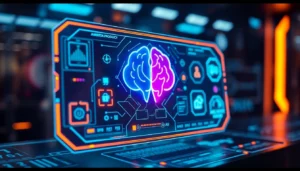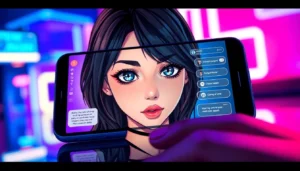Introduction to AI Chatbots in 2025: Evolution and Impact
In the rapidly advancing digital landscape of 2025, AI chatbots have become an integral part of our daily lives, transforming the way we communicate, work, and seek entertainment. Over the past few years, these intelligent virtual entities have evolved from simple scripted responders to sophisticated companions capable of complex emotional interactions, creative collaborations, and personalized assistance. This evolution reflects not only technological progress but also a shift in societal expectations regarding human-computer interactions. As AI chatbots continue to improve, they are now capable of understanding nuanced emotions, adapting to individual preferences, and providing services that were once thought impossible for machines. This comprehensive guide aims to explore the best AI chatbots of 2025, their features, use cases, and the profound impact they have on personal and professional spheres.
Top AI Chatbot Platforms Today: Features and Innovations
The landscape of AI chatbots in 2025 is diverse and vibrant, with platforms continually innovating to meet the needs of different user groups. Leading the pack is AI chatbot platforms that combine cutting-edge natural language processing , emotional intelligence, and multimedia capabilities. These platforms are not just about answering questions—they’re about creating meaningful interactions, whether for productivity, entertainment, emotional support, or companionship.
Some of the most prominent platforms include ChatGPT, Crushon.ai, Character.AI, Replika, and Jasper AI. Each offers unique features tailored to specific needs, from casual conversations and role-playing to creative writing and mental wellness. The innovation in this space is driven by advanced AI models such as GPT-4, Claude, Gemini, and others, which enable these bots to generate contextually relevant and human-like responses that can even express emotions or humor. The integration of multimedia, including images and voice, further enhances these interactions, making AI chatbots more immersive and engaging than ever before.
Deep Dive into Crushon.ai: The Unfiltered, Emotion-Rich AI Experience
Among the standout platforms in 2025 is Crushon.ai, renowned for its unfiltered, dynamic storytelling and highly customizable AI companions. Unlike many platforms that impose restrictions on adult content or NSFW interactions, Crushon.ai supports open-ended, emotion-rich conversations that can range from playful banter to intense romantic roleplays. This flexibility is made possible through its support for over seventeen different models, including GPT-4o mini, Claude Haiku, and the newly released Ultra Claude 3.5 Sonnet, each fine-tuned for expressive, dramatic dialogues.
One of the groundbreaking features of Crushon.ai is its visual reply system, which converts character AI NSFW chat into immersive visuals. Users can receive context-aware images that reflect the mood, setting, and body language of their AI companions, adding a new dimension to digital interactions. Whether it’s a playful tease, a romantic scene, or a bold declaration, these visuals enhance storytelling and emotional engagement, making Crushon.ai a leader in immersive, emotion-rich AI experiences.
This platform is particularly popular among users seeking unfiltered roleplay, adult conversations, or personalized AI partners that can simulate real-world intimacy and emotional connection. Its advanced models and customization options ensure that users can craft AI personalities that align perfectly with their preferences, making every interaction feel authentic and deeply personal.
Advanced Models and Customization: How AI is Enhancing User Interaction
The backbone of modern AI chatbots in 2025 lies in their advanced models and the ability to customize interactions. Models like GPT-4, Claude, Gemini, and others have been fine-tuned to handle a variety of tasks, from creative storytelling to emotional support. These models are trained on vast datasets, enabling them to understand context, nuance, and even subtle emotional cues.
Customization is key to making AI chatbots truly personal. Platforms like Crushon.ai allow users to select from multiple personalities, tweak the AI’s tone, appearance, and even behavioral traits. This level of personalization is crucial for creating AI companions that feel authentic and relatable. For example, a user interested in romantic roleplay can choose an AI that embodies flirtatious, caring, or adventurous traits, while a professional might opt for a more formal, task-oriented AI assistant.
The integration of multimodal capabilities—such as image generation, voice synthesis, and real-time video—further amplifies the interactive experience. Users can see their AI’s facial expressions, body language, and hear their voice, making conversations more natural and emotionally resonant. This evolution signifies a move towards AI that not only responds intelligently but also expresses itself visually and audibly, mimicking human communication more closely than ever before.
The Role of Visual AI: Transforming Text-Based Conversations into Immersive Experiences
One of the most exciting developments in AI chatbots in 2025 is the rise of visual AI integration. This technology transforms traditional text-based interactions into rich, immersive experiences by providing visual cues, images, and even short videos that align with the conversation. Platforms like Crushon.ai exemplify this trend by offering image reply features that match the tone and context of the dialogue, whether romantic, playful, or bold.
Imagine discussing a romantic scene with your AI partner, and instead of just reading text, you receive a visual representation of the environment, body language, and facial expressions. This not only enhances emotional connection but also allows for more nuanced storytelling. Visual AI also supports roleplay scenarios, where the visual elements help set the scene, convey mood, and add depth to interactions.
Beyond personal use, visual AI has applications in entertainment, education, and therapy. For example, visual storytelling can be used in mental health support to create calming environments or in education to make learning more engaging. As AI models become more sophisticated, the boundaries between text, image, and video blur, creating seamless multimedia conversations that feel truly lifelike.
Benefits and Limitations of Modern AI Chatbots
Benefits
- Personalization: AI chatbots can be tailored to individual preferences, making interactions more relevant and engaging.
- Availability: Unlike humans, AI chatbots are accessible 24/7, providing instant responses regardless of time or location.
- Multilingual support: Many chatbots can communicate in multiple languages, breaking down global communication barriers.
- Cost-effective: They reduce the need for human customer service or personal assistants, saving time and resources.
- Creative collaboration: AI can assist in writing, brainstorming, and content creation, boosting productivity and creativity.
Limitations
- Emotional depth: Despite advances, AI still struggles with understanding deep human emotions and nuanced conversations.
- Inaccuracy: AI can sometimes generate incorrect or misleading information, necessitating human oversight.
- Privacy concerns: Sharing sensitive data with AI platforms raises privacy and security issues, especially with unregulated or untrusted services.
- Dependence: Over-reliance on AI for emotional support or companionship might hinder genuine human relationships.
- Ethical considerations: The unfiltered, adult-oriented AI interactions pose ethical questions about consent, misuse, and emotional manipulation.
Ethical Considerations and Privacy in AI Interactions
The proliferation of sophisticated AI chatbots raises important ethical and privacy issues. As these bots become more emotionally intelligent and capable of engaging in unfiltered content, questions about consent, data security, and potential misuse emerge. Users must be aware of how their data is stored, used, and protected, especially when engaging in sensitive or adult conversations.
Developers are tasked with implementing robust privacy policies, anonymizing user data, and ensuring compliance with global regulations such as GDPR. Transparency about AI capabilities and limitations is also vital to prevent misleading users into believing they are interacting with a human. Ethical AI design should prioritize user safety, respect, and consent, fostering trust and responsible usage.
Moreover, there is an ongoing debate about the psychological impact of deep emotional or adult interactions with AI. While AI can provide comfort and companionship, it should not replace genuine human relationships or be used for manipulative purposes. Balancing innovation with ethical responsibility is crucial as AI continues to evolve.
Future Trends: What’s Next for AI Chatbots and Their Role in Society
The future of AI chatbots promises even greater integration into our lives, with advancements in emotional intelligence, multimodal interactions, and contextual understanding. Here are some key trends expected to shape the next era of AI chatbots:
- Emotionally adaptive AI: Future models will better recognize and respond to human emotions, providing comfort, motivation, or empathy as needed.
- Seamless multimodal experiences: Integration of voice, video, and augmented reality will create immersive interactions that feel indistinguishable from real-life conversations.
- Personalized AI ecosystems: Platforms may develop interconnected AI assistants that manage various aspects of a user’s life, from health to finance to entertainment.
- Enhanced ethical frameworks: Stricter regulations and ethical guidelines will govern AI behavior, especially concerning adult content and emotional manipulation.
- AI in societal roles: AI chatbots will increasingly support mental health, education, and customer service, reducing workload and increasing accessibility globally.
As these trends unfold, society will need to address questions about dependency, authenticity, and the boundaries of AI capabilities. Responsible development and usage will be essential to harness the benefits while mitigating risks.
FAQs: Everything You Need to Know About AI Chatbots
1. What is an AI chatbot?
An AI chatbot is a software application powered by artificial intelligence that can simulate conversations with users. These bots utilize advanced natural language processing and machine learning algorithms to understand and respond to text or voice inputs, assisting with tasks, answering questions, or providing companionship.
2. How do AI chatbots work?
AI chatbots operate by analyzing user inputs through NLP techniques, understanding the context, and generating appropriate responses using trained language models like GPT-4, Claude, or Gemini. They learn from large datasets and can adapt responses based on user interactions, making conversations more natural over time.
3. Can AI chatbots replace human interaction?
While AI chatbots can mimic human conversation and provide emotional support, they cannot fully replace genuine human interactions. They are tools designed to augment communication, offer companionship, or assist with tasks, but emotional depth and empathy are still limited compared to real people.
4. Are AI chatbots safe to use?
Generally, yes, especially when used on trusted platforms with strong privacy policies. However, sharing sensitive information requires caution, and users should be aware of data collection and privacy practices to avoid potential misuse.
5. Can I use an AI chatbot for free?
Many AI chatbots offer free versions with basic features. Premium or advanced functionalities, such as emotional intelligence or customization, often require payment. Platforms like Crushon.ai or Jasper provide tiered access depending on user needs.
6. How do I get started with an AI chatbot?
Getting started is typically straightforward: choose a platform , sign up, and follow onboarding instructions. Most platforms provide tutorials to help you customize your AI experience.
7. What can I talk about with an AI chatbot?
You can discuss a wide range of topics—from casual chats, questions, and creative ideas to emotional support, roleplay, or professional tasks like writing and brainstorming.
8. Are AI chatbots only for entertainment?
No, AI chatbots serve multiple purposes: productivity, mental health support, language learning, creative collaboration, and more. While entertainment is common, their roles extend far beyond that.
9. Can AI chatbots understand different languages?
Yes, many advanced AI chatbots support multiple languages. Their fluency depends on their training data, but most can handle common languages effectively, facilitating global communication.
10. What should I do if my AI chatbot gives incorrect information?
Always verify critical information from reliable sources. If inaccuracies occur, provide feedback to developers to improve responses. Remember that AI is not infallible and should complement, not replace, human judgment.
Conclusion: Embracing the Future of AI Companions and Assistants
The landscape of AI chatbots in 2025 is more dynamic and promising than ever. From versatile virtual assistants like ChatGPT to emotionally rich companions like Crushon.ai and Replika, these AI entities are reshaping our digital experiences. They offer unprecedented levels of personalization, immersion, and emotional engagement, making them invaluable tools across various domains. As we continue to integrate AI into our daily routines, it’s crucial to approach these technologies responsibly, respecting privacy, ethical boundaries, and the limitations inherent in artificial intelligence. Whether you’re seeking knowledge, entertainment, emotional support, or creative collaboration, the best AI chatbots of 2025 are equipped to meet your needs and enhance your digital life. Embrace this revolution in human-computer interaction and explore the limitless possibilities that AI chatbots offer.
For those interested in exploring further, discovering the right AI chatbot tailored to your needs can open new horizons of interaction and personal growth. As technology advances, these digital companions will only become more sophisticated, intuitive, and human-like, heralding a new era of seamless, emotionally rich, and productive connections.



